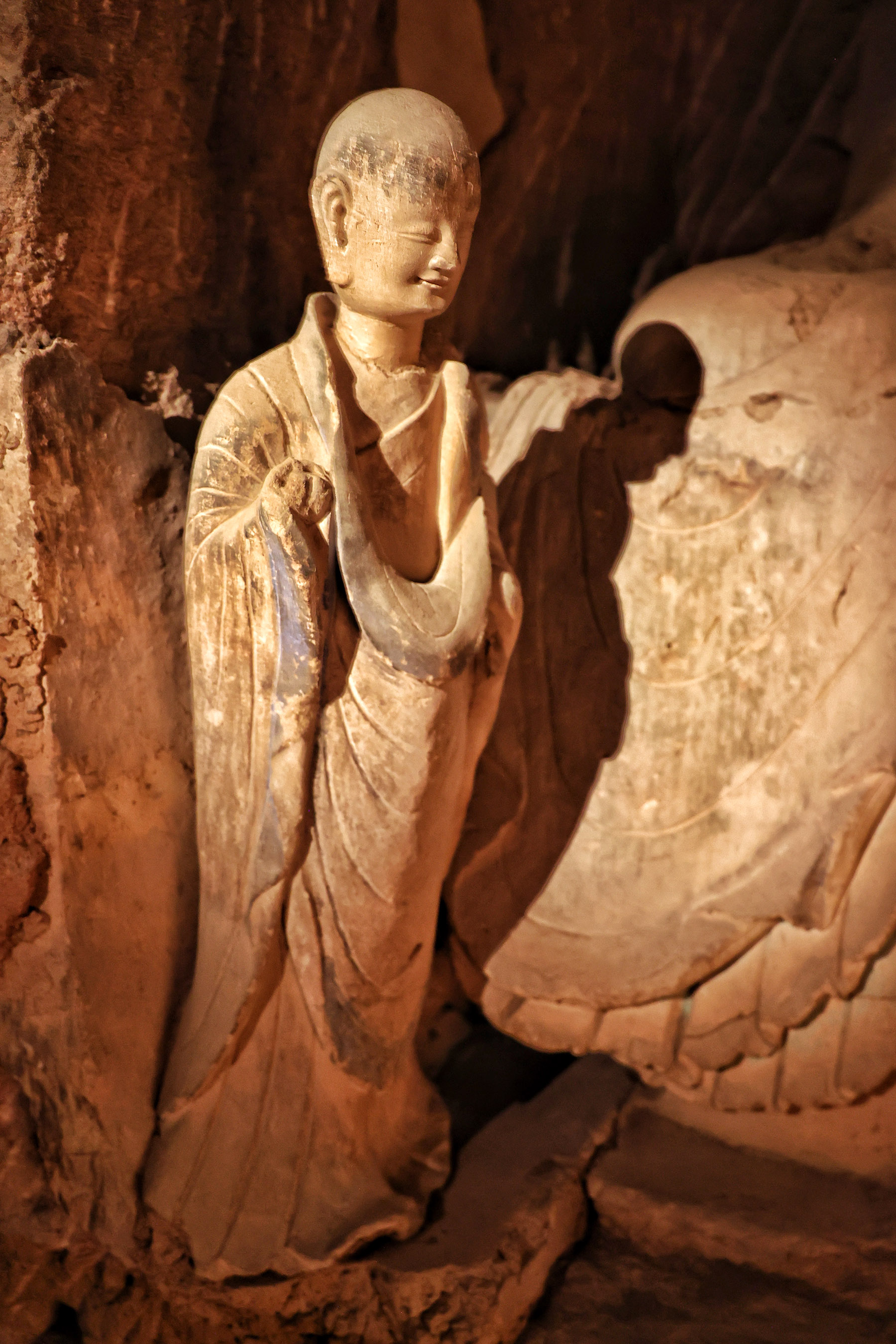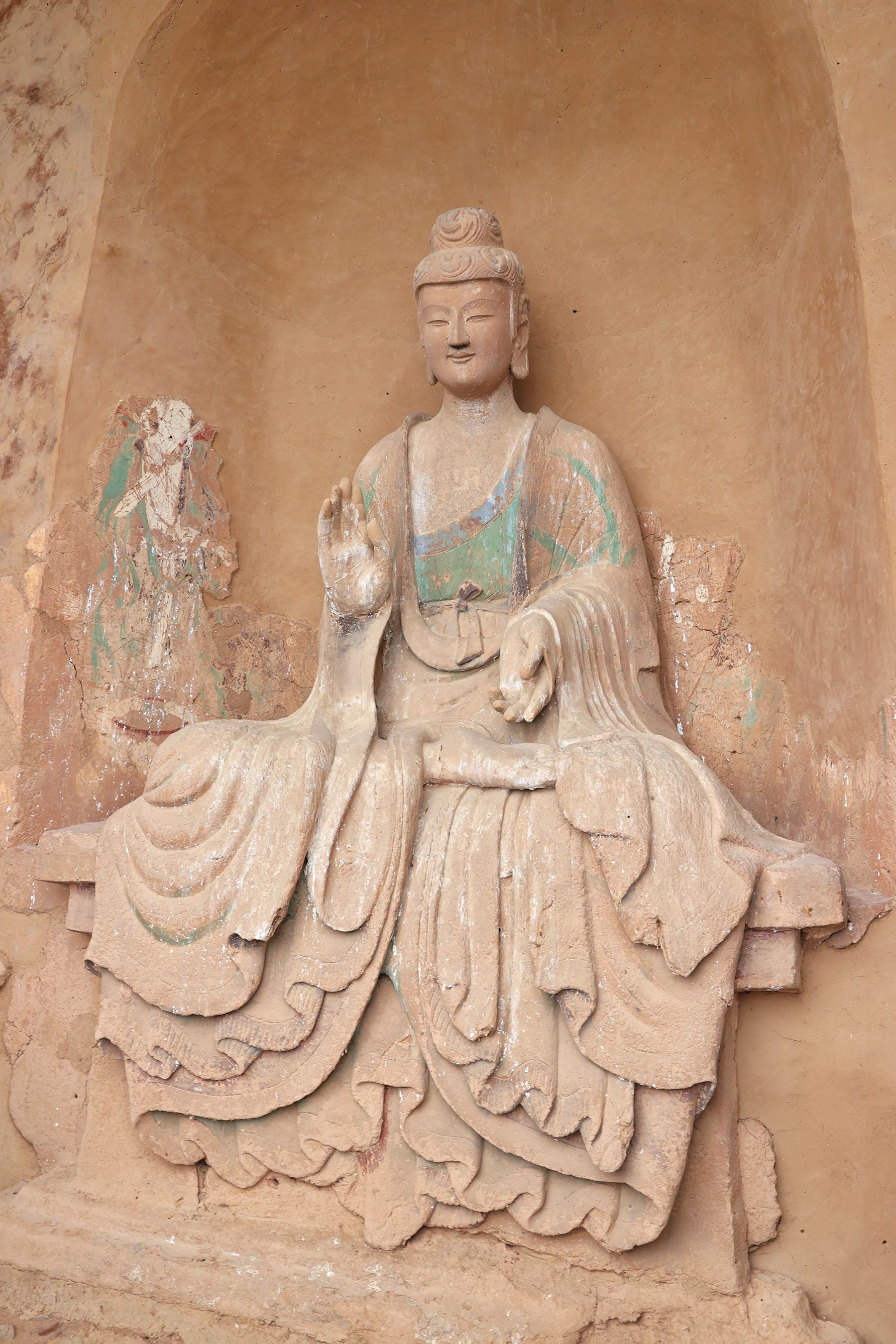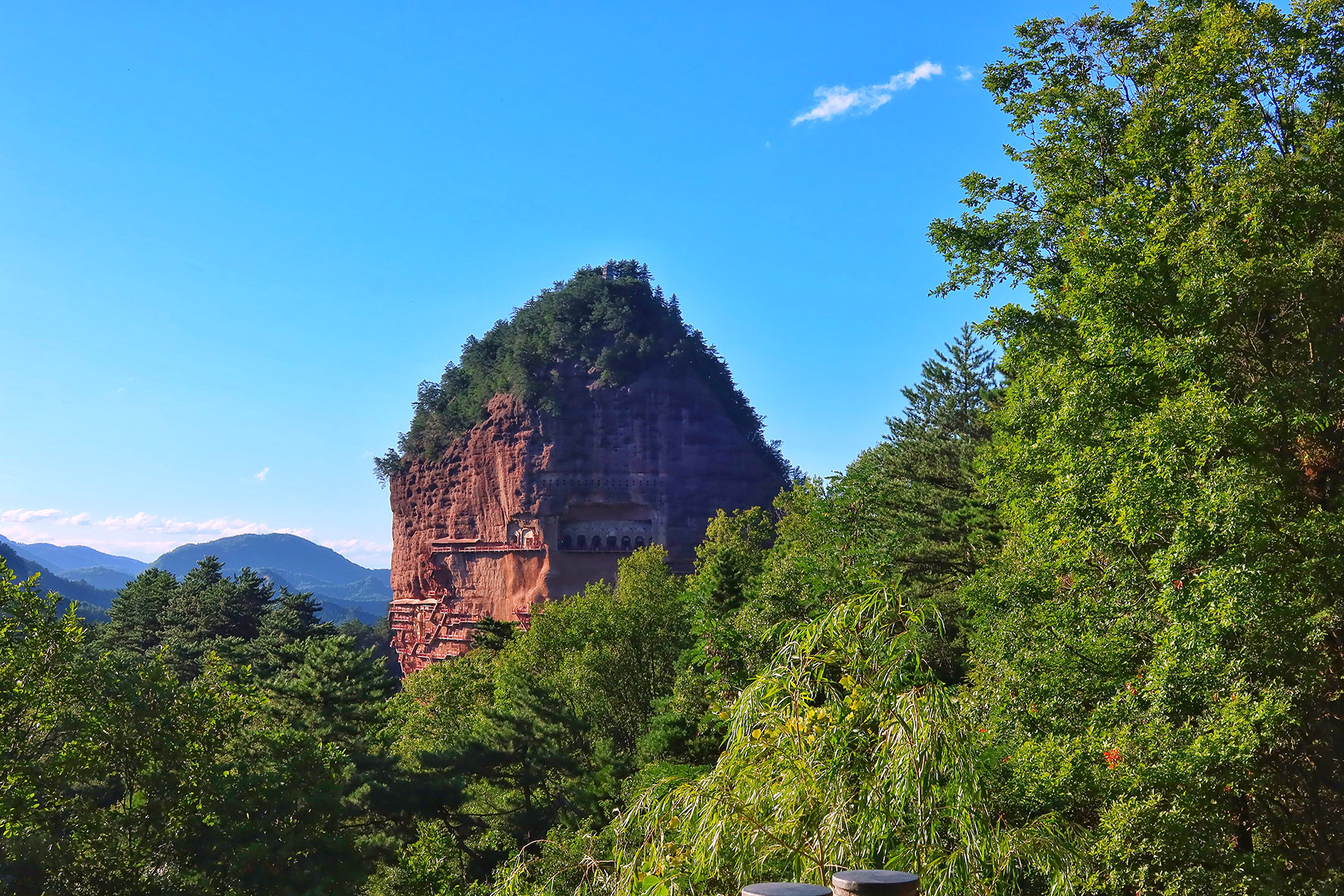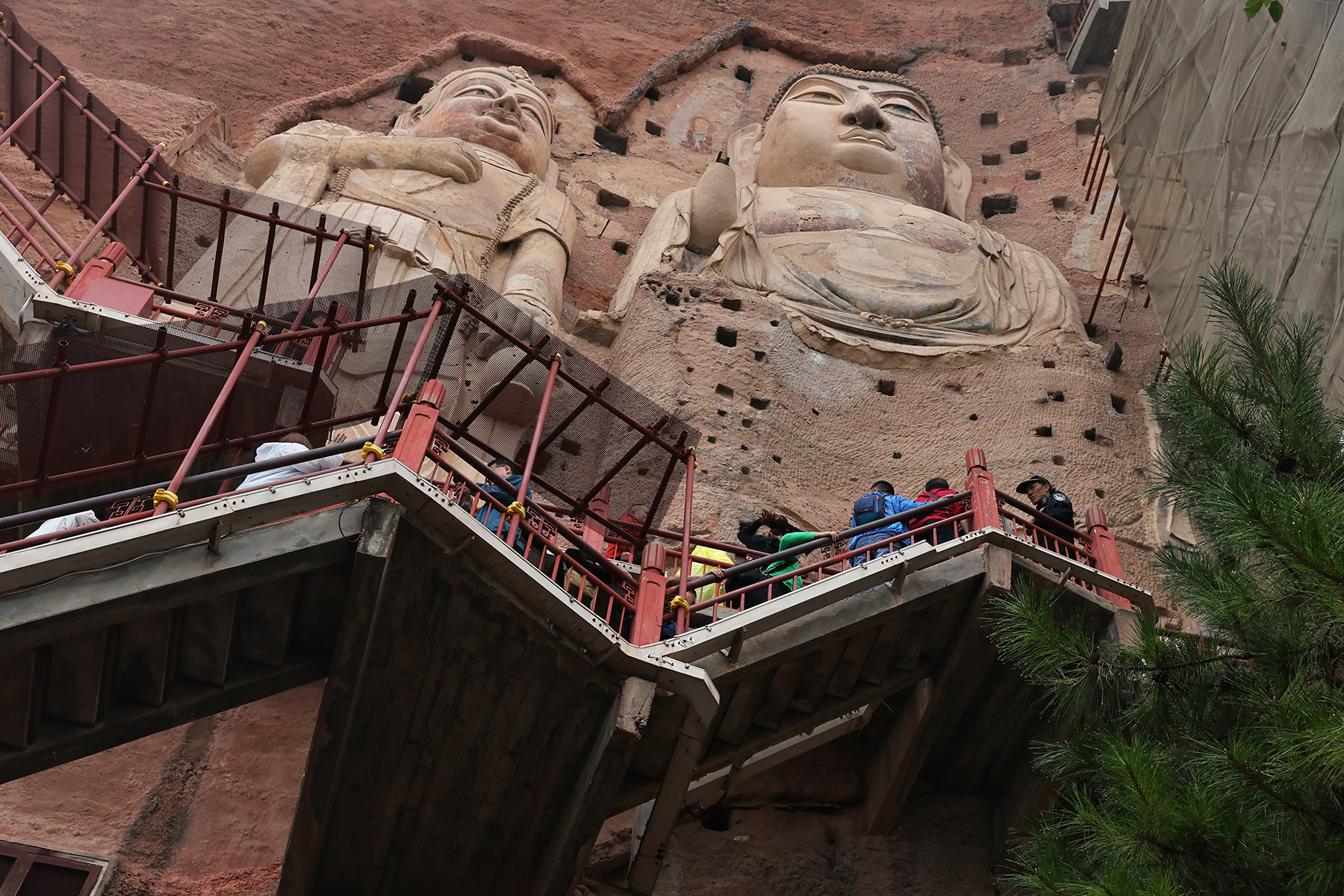Technology and devoted workers help extend life of ancient cave temple complex, Wang Ru reports in Tianshui, Gansu province.

From the memories of Mu Changyou, a 59-year-old resident of Maiji village in Tianshui, Gansu province, he would recall often looking up to see the giant Maiji (wheat stack) Mountain in his family's courtyard. Similar to a wheat stack, the mountain is home to many ancient Buddhist caves carved into the cliffside, collectively known as the Maijishan Grottoes.
In 1985, he received an opportunity to work on the mountain he had grown up seeing every day, becoming a restorer of the cultural relics in the caves. From an apprentice cleaning caves and organizing tools to a master training students, he has devoted four decades of his life to accompanying and extending the lives of his old friends.
READ MORE: UNESCO, China's Gansu collaborate in heritage protection
Mu is one of the many professionals who protect the Maijishan Grottoes, a cave temple complex known as "a gallery of Eastern statues", due to its particularly complete chronological sequence of its statues, built by pious ancient Chinese people from the Sixteen Kingdoms period (304-439) to the Qing Dynasty (1644-1911).
As part of the UNESCO World Heritage site, "Silk Roads: the Routes Network of Chang'an-Tianshan Corridor", Maijishan Grottoes have 221 caves, 161 of which still house Buddhist statues or murals. However, time has taken its toll on this old site, and heritage protectors have explored various ways to protect it.

Over the past eight decades, from establishing files and consolidating dangerous rocks to the successful application for World Heritage status, generations of heritage protectors have contributed great efforts to its protection, says Yue Yongqiang, deputy director of the Art Institute of Maijishan Cave-Temple Complex, which oversees the site.
For example, unlike the common impression that Northwest China's Gansu province is an arid region, Tianshui, located in the southeastern area of the province, receives abundant rainfall, which causes water damage to the caves.
"Compared to many other important cave temples in China, which have stone statues, Maijishan Grottoes have clay statues with wooden frames or stone fetuses, just like those in Dunhuang, Gansu. In such a humid environment, the statues and murals here are more difficult to protect than in Dunhuang," says Hu Junjian, deputy director of theprotection and research office of the institute.
Dunhuang is home to the Mogao Caves, a UNESCO World Heritage site on the ancient Silk Road, with more than 700 Buddhist caves that feature exquisite murals and statues from the 4th to the 14th centuries.
Water damage is a major challenge for the Maijishan caves. In 2018, after two weeks of continuous rainfall, cave 127 reached humidity of 100 percent in the following three months, leading to an outbreak of microorganisms. Protectors then found a large area on the northern side of the cave, paved with a white flocculent mass.

Researchers sampled the substance and took it to a laboratory to identify it. They conducted experiments to select the proper methods of cleaning the flocs and applied a sterilizing agent, which was effective and environmentally friendly, in the cave to remove the mass. In 2019, their approach succeeded, removing the microorganisms and impeding their continued spread in the cave.
Xu Bokai, another deputy director of the institute's protection and research office, says they began studying the water seepage paths inside the mountain body to take specific steps to block the cracks.
Moreover, the site is rich in biodiversity due to its location in a forest zone, where animal and insect activities have a major influence on the cultural remains.
For example, complex-toothed flying squirrels often defecate on the precious relics, causing damage to the stone statues and murals, and insects crawl on murals, directly touching the pigment layers and causing them to flake.
"The squirrels have a habit of excreting in a fixed location, which means they wander around the forest to find food, but go back to a chosen place to defecate. After a while, the place darkens and deteriorates," says Xu.
Therefore, they try to reduce animal and insect visits to the relics by using harmless equipment to deter them and prevent such damage.
"But such influences can never be eliminated because we cannot interfere with the animals' activities too much. We must keep the ecological balance," says Hu.

Since 2020, they have also collaborated with scholars from Peking University to discover methods to save the already blackened areas. Xu says that after multiple experiments, they developed a solution using artificial saliva as the major component, which can decompose hazardous substances in excrement. This is the first attempt nationwide to deal with damage of this kind.
"Since statues and murals are fragile, we have conducted experiments with the solution on the grottoes' trestle roads and cliffside to see if it's reliable and effective enough. Then we will understand if it's safe to use on the statues and murals," Xu says.
In a 2017 survey on what leaves the deepest impression on visitors to Maijishan, more than one-fourth mentioned the trestle roads.
Maijishan's caves and niches are carved into the sheer cliffs, 20 to over 80 meters above ground. The hanging trestle roads crisscross the cliff, linking the caves and forming as many as 12 levels.
ALSO READ: Xi: Grottoes are treasures of civilization
"For many other cave temples, trestle roads may be nothing but an accessory for tourism, but for Maijishan's steep terrain, the roads are lifelines," says Yue.
"In ancient times, people could build caves on the cliff using the trestle roads. Now, visiting the site and our protection work are impossible without the existing steel-reinforced concrete trestle roads built in the 1970s and 1980s."
After over four decades, the roads are part of the cultural heritage, and their safety and reliability continue to keep heritage protectors busy.
"We check the stability of the trestle roads every 10 years. By setting up monitoring facilities that record the level of shaking on key sections of the roads and other scientific methods, we have learned their load-bearing limits and concluded that they are very safe and reliable. Tourists are free to visit," says Hu with the protection and research office.
Maijishan is also taking preventive measures for protection through organizing human patrols regularly and building a monitoring system that collects information, including changes in the neighboring environment, the grottoes bodies and in the number of tourists. Based on the information, the system alerts to risks, such as storms and earthquakes; and offers reference for decision-making.
"Technology is becoming increasingly advanced, making our protective endeavors more precise. The work demands are also increasing. We want to do our best to extend the life of this cultural heritage," says Xu.
Ma Jingna contributed to this story.
Contact the writer at wangru1@chinadaily.com.cn


